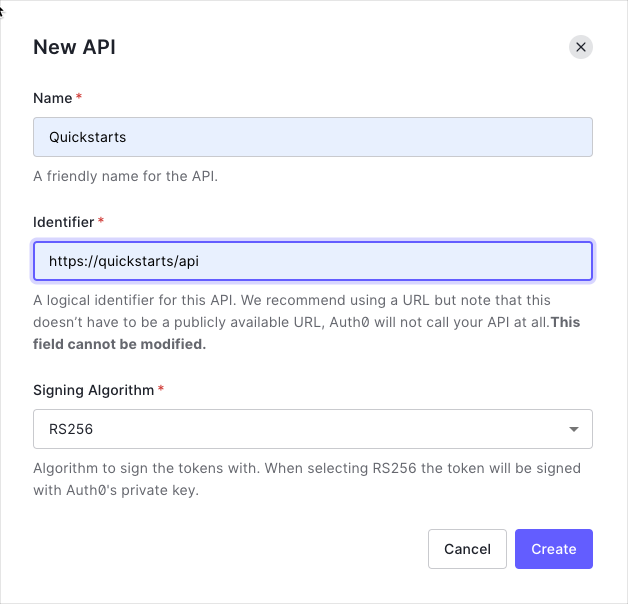By Jim Anderson
This tutorial demonstrates how to add authorization to an API using the Okta Spring Boot Starter.We recommend that you log in to follow this quickstart with examples configured for your account. This example demonstrates:- How to check for a JSON Web Token (JWT) in the
Authorizationheader of an incoming HTTP request. - How to check if the token is valid, using the JSON Web Key Set (JWKS) for your Auth0 account. To learn more about validating Access Tokens, see Validate Access Tokens.
New to Auth0? Learn how Auth0 works and read about implementing API authentication and authorization using the OAuth 2.0 framework.
This Quickstart uses Spring MVC. If you are using Spring WebFlux, the steps to secure an API are similar, but some of the implementation details are different. Refer to the Spring Security WebFlux Sample Code to see how to integrate Auth0 with your Spring WebFlux API.
Configure Auth0 APIs
Create an API
In the APIs section of the Auth0 dashboard, click Create API. Provide a name and an identifier for your API, for example,https://quickstarts/api. You will use the identifier as an audience later, when you are configuring the Access Token verification. Leave the Signing Algorithm as RS256.

Define permissions
Permissions let you define how resources can be accessed on behalf of the user with a given access token. For example, you might choose to grant read access to themessages resource if users have the manager access level, and a write access to that resource if they have the administrator access level.
You can define allowed permissions in the Permissions view of the Auth0 Dashboard’s APIs section.

This example uses the
read:messages scope.Configure the Sample Project
The sample project uses a/src/main/resources/application.yml file, which configures it to use the correct Auth0 Domain and API Identifier for your API. If you download the code from this page it will be automatically configured. If you clone the example from GitHub, you will need to fill it in yourself.
| Attribute | Description |
|---|---|
okta.oauth2.audience | The unique identifier for your API. If you are following the steps in this tutorial it would be https://quickstarts/api. |
okta.oauth2.issuer | The issuer URI of the resource server, which will be the value of the iss claim in the JWT issued by Auth0. Spring Security will use this property to discover the authorization server’s public keys and validate the JWT signature. The value will be your Auth0 domain with an https:// prefix and a / suffix (the trailing slash is important). |
Install dependencies
If you are using Gradle, you can add the required dependencies using the Spring Boot Gradle Plugin and the Dependency Management Plugin to resolve dependency versions:pom.xml file:
Protect API endpoints
The routes shown below are available for the following requests:GET /api/public: available for non-authenticated requestsGET /api/private: available for authenticated requests containing an access token with no additional scopesGET /api/private-scoped: available for authenticated requests containing an access token with theread:messagesscope granted
SecurityFilterChain, and add the @Configuration annotation.
The example below shows how to secure API methods using the HttpSecurity object provided in the filterChain() method of the SecurityConfig class. Route matchers are used to restrict access based on the level of authorization required:
Java
By default, Spring Security will create a
GrantedAuthority for each scope in the scope claim of the JWT. This is what enables using the hasAuthority("SCOPE_read:messages") method to restrict access to a valid JWT that contains the read:messages scope.Create the API controller
Create a new record namedMessage, which will be the domain object the API will return:
Java
APIController to handle requests to the endpoints:
Java
Run the Application
To build and run the sample project, execute thebootRun Gradle task.
Linux or macOS:
spring-boot:run goal.
Linux or macOS:
http://localhost:3010/. Read about how to test and use your API in the Using Your API article.

